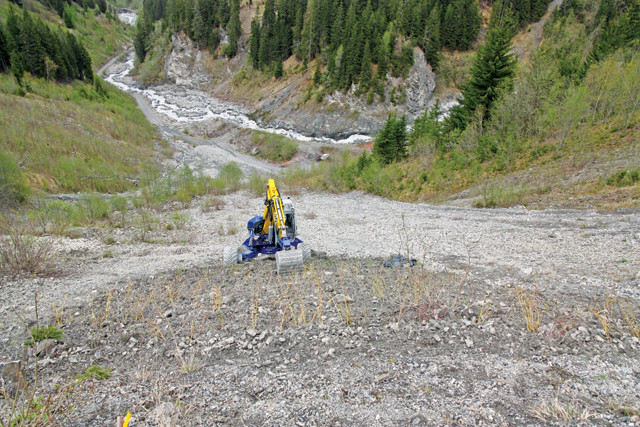
by Bethany Augliere Wednesday, January 18, 2017

Researchers dug small terraces into the slope where rooted plants were placed. Credit: Alexander Bast.
The steep slopes of Switzerland’s high Alps are unstable — with loose soil and few plants — which poses hazards such as shallow landslides. In a new study, researchers have found that the symbiosis between plant roots and mycorrhizal fungi helps ground gravelly hillsides, suggesting a possible eco-engineering tool to stabilize the slopes.
The increased rain predicted to come with climate change is likely to also increase slope instability, says Alexander Bast, a geoscientist at the Swiss Federal Institute for Forest, Snow and Landscape Research and lead author of the new study, published in the Journal of Geophysical Research: Biogeosciences. “We have to do something to control the erosion.”
In the first field study of its kind, Bast and his colleagues tested how fungi improve the stability of steep, erosion-prone slopes in the eastern Swiss Alps.
In 2010, the researchers established two experimental sites on a sparsely vegetated hillslope 1,200 to 1,400 meters above sea level. At each site, the team dug 15 terraces in the soil up to 10 meters long and about half a meter deep, planting a mix of alders, willows, and other trees and shrubs in the bottom of each terrace, for a total of 1,200 plants per site. A third site designated as a control was terraced but not planted. The scientists inoculated the plant roots at one site with 40 milliliters of a commercially prepared mycorrhizal treatment, adding fungi to the system. Mycorrhizal fungi improve the survivorship of plants by helping plant roots acquire key nutrients such as nitrogen, phosphorus and water. In return, plants provide the fungi with carbohydrates from photosynthesis.
For three growing seasons, Bast’s team monitored the plants and took measurements every September on plant survival and growth, including root lengths and diameters, as well as on its stability. Directly measuring soil stability is difficult, particularly in these harsh environments, so the researchers used a common proxy called soil aggregate stability. To test this, the scientists took soil samples, placed them on a sieve in a drainable pail and soaked them in water. They collected and dried the material that passed through the sieve, as well as the trapped material. The aggregate soil stability was determined by comparing the proportion of this unstable material that went through the sieve to the total soil sample.
After the first year, the terraces without fungal treatment were more stable. “That’s what we didn’t expect,” Bast says. In previous greenhouse studies, his colleagues had found that inoculated plants led to more stable soils after just four months. The explanation in the new study, he says, may lie in the roots.
When fungi colonize plant roots, fine hair-like projections called hyphae extend from the fungi into soil to fetch nutrients. “At the mycorrhizal treated site, the plants are not forced to forage farther away into the soil for water and nutrient acquisition,” Bast says, because the fungi are doing much of the work for the plants. So, the plants grow thicker but shorter roots to stabilize themselves. Without the fungi, however, plants grew thinner and longer roots that sprawled through the soil to soak up enough nutrients, which led to increased soil stability.
However, after three seasons, the situation reversed and the inoculated sites showed higher stability than the non-inoculated sites. With the aid of their fungal partners, more saplings survived at the inoculated sites, ultimately leading to more expansive networks of fine roots belowground.
The study shows that “there are benefits to using a fungal inoculum in restoring a quite degraded alpine environment,” says Paul Hallett, a soil scientist at the University of Aberdeen in Scotland who was not involved in the study.
Many lab-based agricultural studies have linked mycorrhizal fungi to soil stability, Hallett says. In both greenhouse and field studies, fungi help with plant growth and soil stability, but there is a temporal offset between the two types of studies. Soil used in this study was sterilized, and microorganisms and their interactions are known to play a role in plant growth, which could explain the differences, Bast says. It may have taken some time for colonies of microorganisms to reestablish in sterilized soils such that they could impact soil stability.
“The extension to the mountain environment makes this study novel,” Hallett says, as does “the fact that they have verified field data.”
However, it’s important that scientists do not assume that results at the small scale will be similar at larger scales in the field, says Alexia Stokes, a biophysicist at the French National Institute for Agricultural Research who was not involved with the new study. Stokes says this study may be part of a growing push toward nature-based solutions and ecosystem services that use the environment itself to protect against natural disasters. “This isn’t quite at the level of natural disasters but maybe it’s the first step, or it’s the smallest scale, I suppose, in helping prevent against landslides or erosion,” she says.
Bast says it would be useful to look next at how the fungi change plant roots at a cellular level, as well as to establish more field sites. Hallett agrees, noting that “tests on a wide assortment of environments exploring the influence of both plant and microbial diversity on stabilization would be beneficial” in exploring the use of eco-engineering options to help mitigate hazards and potentially restore degraded environments.
© 2008-2021. All rights reserved. Any copying, redistribution or retransmission of any of the contents of this service without the expressed written permission of the American Geosciences Institute is expressly prohibited. Click here for all copyright requests.